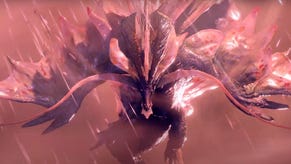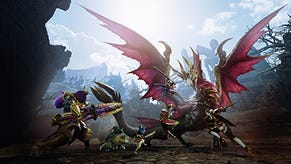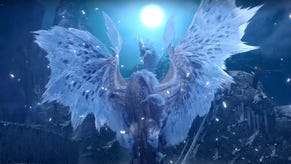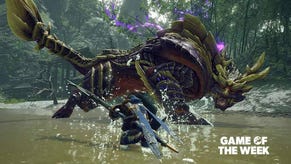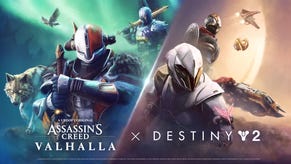Monster Hunter Rise looks like it'll be the best of both worlds
Tsujimoto and Ichinose on going portable, getting quirky and why a 15th weapon isn't on the cards just yet.
Even though Tokyo Game Show was a purely online affair this year, some traditions remain - namely that Monster Hunter stole the show, this year with the announcement of Monster Hunter Rise, the new Switch-exclusive installment that's getting a global release on March 26th next year.
It's the series' debut in Capcom's RE Engine - indeed, it's the RE Engine's debut on the Switch - and the first proper dedicated Monster Hunter for Nintendo's hybrid device following the port of the 3DS' Generations back in 2018. Generations' director Yasunori Ichinose returns to the director's chair for Rise, bringing a fair few ideas from the breakout success that was Monster Hunter World.
The map's more diverse, with no need for loading screens between areas, while other new additions include the palamutes - canine companions who'll help you sniff out monsters while also serving as mounts - and most excitingly the introduction of a wire bug, a device that acts like a grappling hook and allows you to traverse all sorts of terrain. It's all very Breath of the Wild, in the best possible way.
What's really exciting, though, isn't so much what's been added as what's been restored. Monster Hunter's always been brilliantly suited to playing on the go, and to local networked play - and alongside reintroducing all of that, there's a strain of silliness that was slightly absent in the most serious Monster Hunter World returning with aplomb.
All of which is to say Monster Hunter Rise is looking very, very exciting indeed. We sat down for a short while with series' producer Ryōzō Tsujimoto and Monster Hunter Rise director Yasunori Ichinose to find out more.
Let's start with an easy one! How long has this been in development for?
Ryōzō Tsujimoto: It's been about four years in total. Ichinose was the director of Monster Hunter Generations, which came out about four or five years ago. And we did give him a bit of time off after that! It wasn't like the next day! But we asked him if he could work on the next portable - at the time it hadn't been released - Switch title. And we also had to consider what engine to use at the same time before we get started. We're using the RE Engine which at the time had not yet been released, because the first title using it was Resident Evil 7. So yeah, long story short it was a total of about four years once we got all those ducks in a row.
So development had started before Monster Hunter World came out. Did you ever explore the option of bringing that to Switch? I know plenty of people asked questions about it - including myself! - around release.
Ryōzō Tsujimoto: To be honest not really, because we do treat each title as its own concept and you can't ignore the hardware you're releasing it on when you design the game. If you've got something like Nintendo Switch which is pick up and play, you can play it anywhere, you don't necessarily want the same gameplay experience which is designed assuming you're sitting in front of a big TV on a sofa for four hours straight. We want to be able to design a game that you can pick up for 30 minutes on the go, before bed, and get something out of that experience, and that that really affects the gameplay design and you can't just bring that over and have it be the same, so we never really considered that when it came to Monster Hunter World.
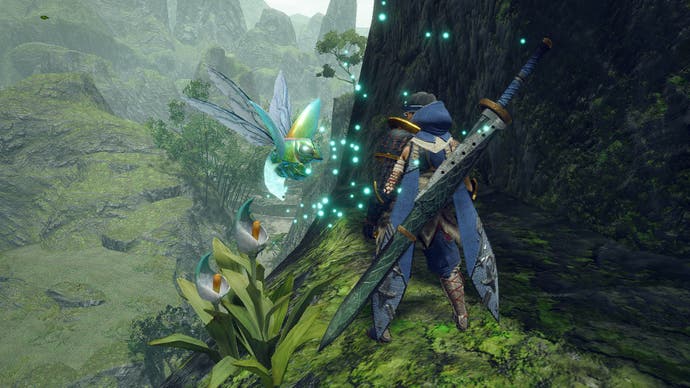
It's quite awesome that you've gone with the RE Engine as well - it's a fantastic engine and that's worked wonders on Capcom's titles in recent years. How much of a challenge was it getting that on Switch?
Yasunori Ichinose: It was definitely a new challenge for us. As you mentioned, it was indeed our first time bringing an RE Engine title onto the Switch. So a lot of background technical engineering work needs to be done just to achieve targeting a new hardware platform. Of course, being an internal Capcom engine, that meant that we had the benefit of all the expertise and knowledge of our engineers to hand - they worked very hard, getting the engine working for us and ensuring that we could take the game content which involves these not strictly open world per se but large maps with no loading areas between them, having those work seamlessly whilst maintaining the graphics quality we wanted, to keep that stuff in without affecting performance and having the frame rate be something that could achieve our targets - a lot of all that stuff was a difficult balance to achieve but I think that the team has really pulled it off, targeting a comfortable 30 frames per second whilst also making the game look as good as it does and pushing the power of the Switch as much as we can. It's been a challenging but rewarding experience.
And obviously it's the first time Monster Hunter has been in RE Engine as well. I know you won't be able to talk to future titles so much, but does that mean Monster Hunter will be using that engine game now going forward?
Ryōzō Tsujimoto: Actually even putting aside Monster Hunter as a series, the RE Engine is Capcom's latest up-to-date internal engine. And yeah, I think our goal overall is to have as many of our games as possible eventually running on our engine.

And it looked incredible as well. I was kind of amazed that you had it running on the Switch - was what we saw at TGS running on a vanilla Switch?
Ryōzō Tsujimoto: It was all running on Switch - everything you saw at TGS.
I know you won't be able to talk to Nintendo's plans at all, but I find it interesting that there's a lot of quite high profile titles coming out next March, and speculation about a new Switch. If - in theory - there was a new Switch would you be well positioned to kind of take advantage of that?
Ryōzō Tsujimoto: Well, obviously we have no idea whatsoever what the plans would be in that direction, but even at the moment you actually have two different Switch hardwares you're targeting - you've got the the original Switch which has the docking mode, so that's something we've already borne in mind to make sure that the game isn't making any undue assumptions on the hardware owned by the player. As to those kind of plans on Nintendo's side, we can't speak to those at all. We're trying to make the game work as best as it can on whichever Switch you have
To speak more to the design side - as it's going for a more portable audience, what were some of the things missing in the home console-based Monster Hunter World you've been able to bring back for Rise?
Yasunori Ichinose: Certainly one of the biggest things that come to mind straight away is local wireless play. It's something that is not achievable on traditional home consoles, and it's part of the series' history going back a long time. So it's really great to be able to bring your Switches together and play even when you're offline or haven't got access to the internet. And that also expands upon the idea that it's just a kind of a more pick up and play game - that's a different gameplay experience than sitting on your couch.

I think I'm something of an outlier, but someone like myself, I probably spend about 60-70 per cent of my time on Switch playing docked. So how do you take into consideration that kind of player as well?
Yasunori Ichinose: I wouldn't be able to point to one particular detail. But I think you could say that the key experience is whether you're going to be playing in portable, handheld or docked, you'll be able to enjoy the experience. It isn't like it's so portable that it feels strangely stunted or something. It's a full on Monster Hunter experience, which you can play on the television and get really sucked into. But it's also easy to pick up and play and enjoy at your own pace in whatever size of bite sized chunk you might want to make out of it.
Certainly as well, the fact that the gameplay has these new elements of exploration and traversal, I think that there's a great adaptability of the content, whether the player wants to, you know, sit down with your docked Switch and your controller and really get sucked into that huge world, or whether you want that more personal feeling of having your hunter to hand anytime, it's really up to the player. And we want to be able to cover both types of experience equally well.
There was a perception around Monster Hunter World that it was looking more towards the west to break into that market for the first time properly. And it's something that worked phenomenally well - I should say, congratulations on Monster Hunter World's phenomenal success! Rise feels like it's taking some of those lessons learned and having more focus on the more traditional Japanese audience with what it's doing. Is that a fair assumption to make?
Ryōzō Tsujimoto: We really take each title on its own terms, and we start with each one from zero saying what do we need to put in this game, how do we need to design this particular Monster Hunter to achieve the goals we have and what kind of gameplay experience we want to present. And we really don't zoom in on something like, well, how can we follow up game x with this game? Or you know, how could we implement this and not that we really take it on a game by game basis? So it's difficult to say your assumption was like, correct, because I think we're just kind of in a different mindset.

Just following on from that - there was also a perception that some of the silliness of Monster Hunter, while it was still there in World, it wasn't quite as pronounced. Actually to be more explicit - a friend was upset that the 'So Tasty' quote had gone, and was asking if it would come back.
Ryōzō Tsujimoto: I believe 'So Tasty' is in the game... There's actually a new, extra level of voice clips in general, which you may have noticed watching the footage. A hunter will say certain things during the action. With regards to that kind of taste of how it feels like for the player, we know that some people will know what they think classic Monster Hunter is, some people won't like changes to that sort of thing. So we do try and keep it so that you can adjust the experience to your own taste. So for example, you can actually turn off these voice clips. You can either reduce the frequency or you could even just turn it on to the classic grunts and groans if that's what Monster Hunter is to you. We're aware of the fact that people feel like there's a certain style that feels like Monster Hunter to them, and we want to make sure you can experience that if that's your preference.
One last question. You've been explicit throughout the TGS streams that there's going to be 14 weapons in Rise - the same 14 weapons as in Monster Hunter World. Some people are asking when's it going to be time for that to be 15 weapons, and when's the right time to introduce another weapon into Monster Hunter's ecosystem.
Ryōzō Tsujimoto: I promise I'm not just stubbornly refusing to answer, but... It's really impossible to answer. Adding an extra weapon type would really have to add something new, it would have to add something to the roster that isn't currently present in any of the quite large number of weapons already there. And we also have so many ways that we can increase the depth and breadth of the gameplay that aren't fixated on that idea of an extra weapon, for example, the wirebug mechanic - that adds something to each and every existing weapon, they all have ways you can combine the wirebug with. And that way of taking something which adds on to all 14 weapons adds a depth and breadth, that wouldn't be the same as just saying try different weapons. You know, we just don't think in those kind of terms. We always think, how do we add to the breadth and depth of the experience, and in this case we've chosen to add something to the hunter's toolset in general
I can't complain anyway because I'm probably going to just spend 200 hours playing the long sword because I'm too lazy to learn anything else. So I can't complain at all. Anyway, thank you for your time!




